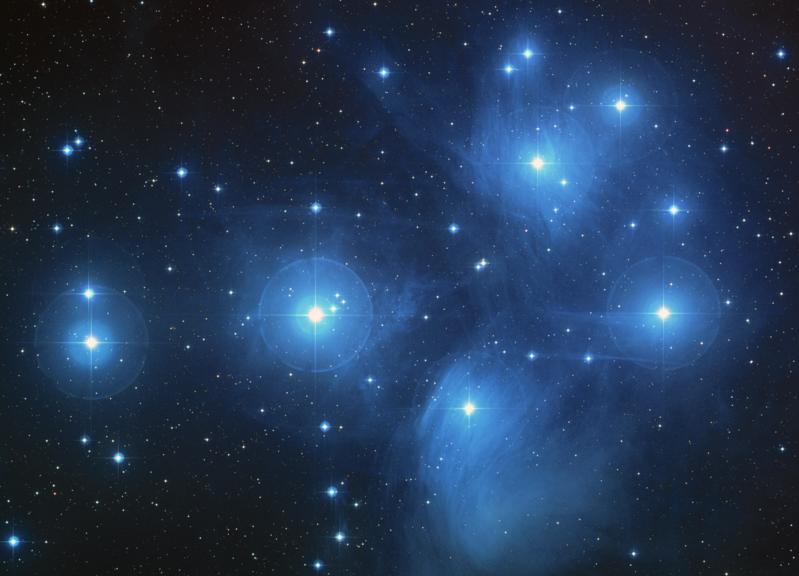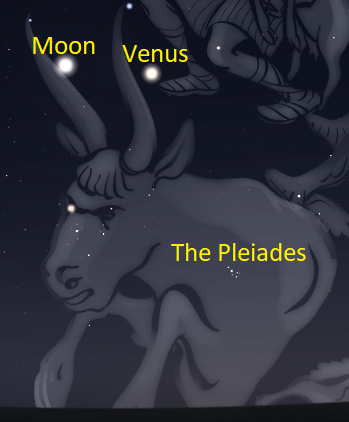Happy birthday, Durham! Your city flag is astronomically wonderful.
April 26, 2020
By Amy Sayle
Durham, North Carolina, which celebrates its birthday today, has an astronomical connection you can see for yourself in tonight’s sky. The seven stars of the Pleiades are represented on Durham’s city flag.
This star cluster (which has a number of other names, including the “seven sisters”) is located in the constellation Taurus the Bull, making it an astronomically excellent choice for a place nicknamed the “Bull City.”
You might also think that this star cluster is a perfect choice for the flag because Durham’s official birthday is April 26, 1853—and April 26 is one of the dates corresponding to the astrological sign of Taurus.
Alas, those dates are wrong. In fact, on April 26, the Sun appears in front of the constellation Aries the Ram, and not Taurus the Bull.
And Durham is not known as “the Ram City.” In fact, “ram” brings to mind a different place altogether, somewhere a few miles down the road from Durham.


But it’s a good thing those dates are wrong. Because if the Sun really were in Taurus right now (April 26), then the Pleiades would be up only in the daytime and you wouldn’t be able to see this lovely star cluster in the sky tonight.
Seeing the Pleiades at this time of year will be tricky, though, because from Earth’s point of view, the Sun is appearing to slide pretty close to the direction of these stars as Earth continues in its annual orbit. Taurus is a winter constellation, which means that’s the season best for seeing it. Spotting anything in Taurus in late April requires looking fairly low in the west as soon as it gets dark.
One way to find the Pleiades is to first find the three bright stars that mark Orion’s belt, then draw an imaginary line to the right. You’ll run into the reddish star Aldebaran, the eye of Taurus the Bull. From there, keep going roughly in that same direction until you run into a fuzzy-appearing little star cluster. That’s the Pleiades.
Right now there’s another way to find the Pleiades, because Taurus apparently decided to throw a party for the Bull City’s birthday this April 26th, 2020:
1. Go outside about 1 hour after sunset. That’s around 9 p.m. for Durham residents and others living near the Triangle.
2. Walk to somewhere in your neighborhood where tall trees or houses won’t block your view of the western horizon (the same direction the Sun set in).
3. Now look for two of Taurus’s party guests. They’re both very bright:
The Moon. It’ll be a thin waxing crescent. The Moon is stopping by the party only briefly; it’ll visit other constellations on future nights.
Venus. This planet looks like a very bright star. On the evening of April 26, 2020, Venus lies just right of the Moon. Venus has been hanging out with Taurus for a while now, but will eventually move on to see other friends in the sky.
4. Finally, look for the Pleiades. On April 26, 2020, this star cluster will be lower than Venus, closer to the western horizon, and possibly challenging to spot. If you’re looking an hour after sunset, the cluster will be about 10 degrees above the horizon, or roughly only about the width of your fist when held at arm’s length.

It’s a celestial party in Taurus for the Bull City’s birthday! Note that the Moon will actually look like a thin crescent the evening of April 26, 2020. Credit: Stellarium.
Normally you might be able to pick out 6 or 7 stars, but tonight, count yourself lucky if you see anything that looks like a fuzzy little blob in that spot. Then wish Durham a happy birthday.
To learn how to use your hands to find more objects in the night sky, check out the North Carolina Science Festival Statewide Star Party activity, A “handy” way to measure the sky.
